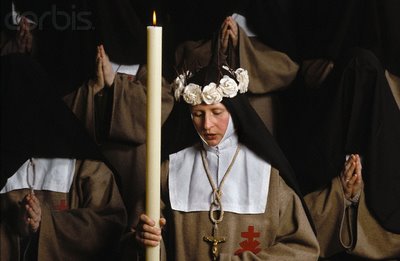What does the word Nun mean and what is the origin of nuns?
The office of consecrated virgins and women goes back to the Israelites of the Old Testament. I documented this claim last month in:

Did Jewish Temple Virgins Exist and was Mary a Temple Virgin?
We find that consecrated women date to the first ages of the New Testament. Saint Paul praises of special virgins for their continence and their devotion to the things of the Lord (1 Cor 7).
Saint Paul also speaks of enrolled widows, who were called to certain kinds of church work (1 Timothy 5:9).
A sign, then, of the true, biblical Church is the presence of these consecrated women. By the way, these are not female priests or married women. They are definitely either virgins or widows. The word “nun” by the way, comes from the Latin nonna – a term of endearment for a grandmother. It is directly related to the English Nana. The consecrated widows, then, bore the title of grandmotherly endearment.
In the second century, Saint Justin Martyr attests to consecrated virgins in Rome. (St. Justin, Apology 1, c. 15). Saint Ambrose attests to their presence in Milan during the third century (De Virginibus, 1, 4).
By the early third century, these women are being called the “spouses” of the Lord Jesus Christ in North Africa and Egypt. St. Cyprian describes a consecrated virgin who had broken her vows as an adulteress (“Epistle 62”). Saint Athanastius in Egypt also describes consecrated virgins as “spouses” of the Lord Jesus Christ (see his Apol. ad Constant., 33). Apocryphal literature of the Pre-Constantinian era is full of references to consecrated virgins and their important role in the Catholic Church.
Virgins vowed themselves to the service of God primarily through prayer. These ancient nuns first lived with their families, but by the third century, they assembled at community convents then called partheuones. After Constantine, these consecrated virgins and women were at liberty to have organized communities and protection from aggression and harm.
Before closing, the veil was the sign of the consecrated. This goes back as far as Tertullian (and probably all the way back to Saint Paul). The veil is the sign that these women belong irrevocably to Christ.
Let us pray a short prayer today asking Christ to give the Church more flowers, that is, more holy women, to bring beauty and sanctity to our Church.
Do you enjoy reading Canterbury Tales by Taylor Marshall? Make it easier to receive daily posts. It’s free. Please click here to sign up by Feed or here to sign up by Email. Please also explore Taylor’s books about Catholicism at amazon.com.
What to Watch Next
SHOP THE TAYLOR MARSHALL STORE
Dive Deeper

GET CONFIDENT IN YOUR FAITH
Explore the fascinating world of Catholic teachings with Dr. Marshall. Together you’ll unpack the brilliant answers the Church gives to tough questions about the Faith. The best part: you go at your own pace. Start this exciting journey today.


 >
>


